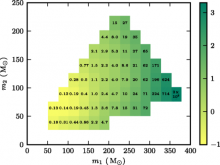
Abstract
This paper reports on an unmodeled, all-sky search for gravitational waves from merging intermediate mass black hole binaries (IMBHB). The search was performed on data from the second joint science run of the LIGO and Virgo detectors (July 2009–October 2010) and was sensitive to IMBHBs with a range up to ∼200 Mpc, averaged over the possible sky positions and inclinations of the binaries with respect to the line of sight. No significant candidate was found. Upper limits on the coalescence-rate density of nonspinning IMBHBs with total masses between 100 and 450 M⊙ and mass ratios between 0.25 and 1 were placed by combining this analysis with an analogous search performed on data from the first LIGO-Virgo joint science run (November 2005–October 2007). The most stringent limit was set for systems consisting of two 88 M⊙ black holes and is equal to 0.12 Mpc−3 Myr−1 at the 90% confidence level. This paper also presents the first estimate, for the case of an unmodeled analysis, of the impact on the search range of IMBHB spin configurations: the visible volume for IMBHBs with nonspinning components is roughly doubled for a population of IMBHBs with spins aligned with the binary’s orbital angular momentum and uniformly distributed in the dimensionless spin parameter up to 0.8, whereas an analogous population with antialigned spins decreases the visible volume by ∼20%.